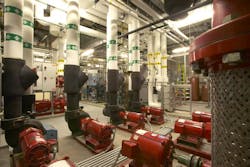Southland Industries CEO Ted Lynch pointed out a project to us that is as emblematic of what’s going on this year as anything. When the economy crashed in 2008, few towns suffered as much as Las Vegas. Vegas had quite a few abandoned projects rusting, including Boyd Gaming’s Echelon resort. But now Malaysia-based Genting Group has purchased the 87-acre site on the Strip and is developing Resorts World Las Vegas. Various sizes have been attributed to the project — the Las Vegas Review Journal said 3,500 rooms and Forbes said 6,000 rooms — and the price tag could be anywhere from $2 billion to $7 billion.
This is going to be a decent year. 2015 will be a better year. Then look for continuous growth through 2018, economist Brian Beaulieu, ITR Economics, told contractors attending this spring’s Mechanical Contractors Association of America convention. The commercial/industrial/institutional markets are in for a very good run.
Viega LLC is the sponsor of this year’s annual CONTRACTOR Book of Giants.
To download a pdf of our complete 2014 Book of Giants, including rankings of the top 100 mechanical contractors in the country by revenue, click here.
For a gallery of our top ten companies by region, click here.
For a gallery of our top ten companies by type of work, click here.
To see breakdowns based on how they get work, markets served, public vs. private and type of work, click here.
Most expect 3%-5%
“A lot of people have been saying 3%-5% for this year and we’ve sort of settled there for the non-res market,” says Anthony J. Guzzi, President and CEO of EMCOR Group, the nation’s largest mechanical contractor. After the tough winter weather experienced in much of the country, Guzzi says he believes that 3%-4% would be a more accurate forecast.
The prominent engineering and construction consulting firm FMI (www.fminet.com) made predictions for a selection of markets in its Construction Forecast. Among them:
Although the residential market is forecast to grow, the pace is slowing. Forecasts show an 18% growth in single-family construction. Multifamily construction will moderate down to a 27% increase in 2014, a drop from the 44% increase in 2013.
FMI notes that investors are beginning to help lift commercial construction out of a slump by taking more risks. The industry is expected to grow another 7% in 2014 to $52.6 billion, the highest mark since 2008. Reed Construction Data reports that the $17.1 billion first quarter commercial starts were the second highest since 2008, notes Reed U.S. Chief Economist Bernard Markstein.
FMI predicts that health care construction will grow 2% in 2014, but the consulting firm is forecasting a jump to 6% in 2015 as the outcomes on new health care regulations become clearer.
“I say this broadly — and we’ll see if it bears out with the numbers next year — is that healthcare construction, other than the small stuff, is on a pause right now because nobody knows how this will shake out,” says Guzzi. “We won’t see clarity now. There are some good drivers, yeah. One of them is outdated facilities, also more people will need them as they get older, and with outdated facilities in terms of new technology and HIPAA (the federal privacy law) you can’t have dual-patients rooms, so building new is better than remodeling. I believe we’ll see a one-to-three year respite, but then it will pick up once financial aspects become clearer.”
Lynch is seeing a similar trend to regional hospitals and medical office buildings.
“We are seeing the type of facility changing,” he says. “We see more medical office buildings because a lot of the large hospitals have already been built, so we’re seeing smaller facilities and regional hospitals. In the D.C. area, private healthcare has lagged so what we’re seeing now is renovations, additions and new hospitals, and that’s just because of the growing population.”
FMI is predicting that improving state and local budgets will help move educational construction back into the growth mode. 2014 will see a 3% level of growth to $83 billion.
To download a pdf of our complete 2014 Book of Giants, including rankings of the top 100 mechanical contractors in the country by revenue, click here.
For a gallery of our top ten companies by region, click here.
For a gallery of our top ten companies by type of work, click here.
To see breakdowns based on how they get work, markets served, public vs. private and type of work, click here.
Data centers suck power
The power market is forecast to grow to $91.2 billion for 2014 with a slow climb from 5% to 9% over the next four years. The cost of new nuclear power will continue to hinder growth until regulatory concerns are considered.
Speaking of power, both Southland and EMCOR continue to see plenty of opportunities in data centers and data centers need electricity.
“There’s a lot of useless data out there that people want to mine even though it’s useless and it hogs lots of capacity,” Guzzi says. “All of it needs to be stored. The other side of that on data centers is that they are big energy users, so more energy capacity will need to be added and more energy efficiency work will be done. So if you have a comparable structure that took 10-15 mW as a printing plant that now uses 50-60 mW as a data center, you’ll see more gas turbine construction. Renewables are not viable — yet — although we will build whatever they want. We’ll see more cogeneration capacity. Those two will help meet data center electrical demand or the mix will shift to that kind of product coupled with the efficiency of gas turbines.”
With signs of sustainable growth, FMI says that predictions are that manufacturing will be up 5% in 2014 to $45.2 billion, and an upward swing with another 8% growth in 2015.
Lynch says that Southland is pursuing large national opportunities and a lot of them are in the manufacturing world. Customers who wish to remain anonymous, but who are mostly in the semiconductor industry, are coming back to America. Lynch says these are highly automated facilities, and equipment intensive.
The industrial market is good, oil and gas are good, as is petrochemical work on the Gulf Coast and mid-Atlantic, Guzzi reports. There’s some reindustrialization going on in the Southeast. The Midwest and Northeast are hanging on to what they have with tax incentives and the like. The U.S. will be a long-term winner, he opines, because of our supply of natural gas. The Europeans have made themselves too dependent on Russian gas and the Germans shut down their nukes too soon.
Economist Beaulieu agrees that U.S. manufacturing will do well because of our energy production and subsequently low energy prices. By 2025 we will be the world’s largest oil exporter, Beaulieu says. Our electricity prices are one-third that of Europe. U.S. manufacturing is 12.5% of our GDP and it’s increasing. Manufacturing has increased by 35% since 1995 but industrial CO2 production is way down.
FMI reports that the lodging industry forecasts 591 hotels opening in 2014 compared with the 500 in 2013. Growth at 13% is expected with this market reaching $16.1 billion. “First quarter lodging starts were at their second highest level since 2009,” says Reed economist Markstein.
To download a pdf of our complete 2014 Book of Giants, including rankings of the top 100 mechanical contractors in the country by revenue, click here.
For a gallery of our top ten companies by region, click here.
For a gallery of our top ten companies by type of work, click here.
To see breakdowns based on how they get work, markets served, public vs. private and type of work, click here.
A talent crunch?
Labor may become an issue in the near future. Southland’s Lynch has seen an increase in hiring for mid-level management and project management talent. Guzzi isn’t worried because EMCOR is the big dog and it has become the employer of choice.
“There are too many opportunities and not enough qualified people is our biggest problem,” says Lynch. “We are seeing a grab for qualified people in a number of markets. People are loading up talent and hiring the top people. Smart companies saw ahead and ramped up their talent pool seeing work that’s coming. We’ve got national opportunities popping up and need a lot of people.”
Economist Beaulieu also sees a talent crunch on the horizon.
“Unemployment is down to around 7% (6.3% at this writing) and at 6% we’re at virtually full employment because it gets difficult to find qualified people,” Beaulieu said at the MCAA convention. “Labor will become more expensive. You will need to have great training programs and some golden handcuffs to hang onto key employees. ... Expect more margin pressure on your bottom line based on labor dollars.”
Beaulieu referred the mechanical contractors to what he calls his “Phase Management Objectives,” an 11-point plan on how to get ready for 2014-2015. The 11 activities are:
- Positive leadership modeling (culture turns into behavior).
- Invest in customer market research (know what they value).
- Training programs (people, process, internal metrics).
- Review and uncover your competitive advantages.
- Spend money on new products, marketing, advertising.
- Improve efficiencies with investment in technologies and software.
- Check systems for readiness to accommodate increased activity.
- Add sales staff and hire top people.
- Lock in costs.
- Judiciously examine your credit.
- Work on “what’s next.”
That checklist sounds like good advice for any year.
And, finally, Beaulieu told the contractors to borrow boatloads of money because they will never see interest rates this low again. Invest the money in equities, real estate, and your business.
All of the economic indicators are rising, so, “Tell your kids to get a job and get out of the house,” Beaulieu said.
To download a pdf of our complete 2014 Book of Giants, including rankings of the top 100 mechanical contractors in the country by revenue, click here.
For a gallery of our top ten companies by region, click here.
For a gallery of our top ten companies by type of work, click here.
To see breakdowns based on how they get work, markets served, public vs. private and type of work, click here.
About the Author
Robert P. Mader
Bob Mader is the Editorial Director for Penton's mechanical systems brands, including CONTRACTOR magazine, Contracting Business and HPAC Engineering, all of which are part of Penton’s Energy and Buildings Group. He has been with CONTRACTOR since 1984 and with Penton since 2001. His passions are helping contractors improve their businesses, saving energy and the issue of safeguarding our drinking water. He is a graduate of the University of Notre Dame with an A.B. in American Studies with a Communications Concentration.



